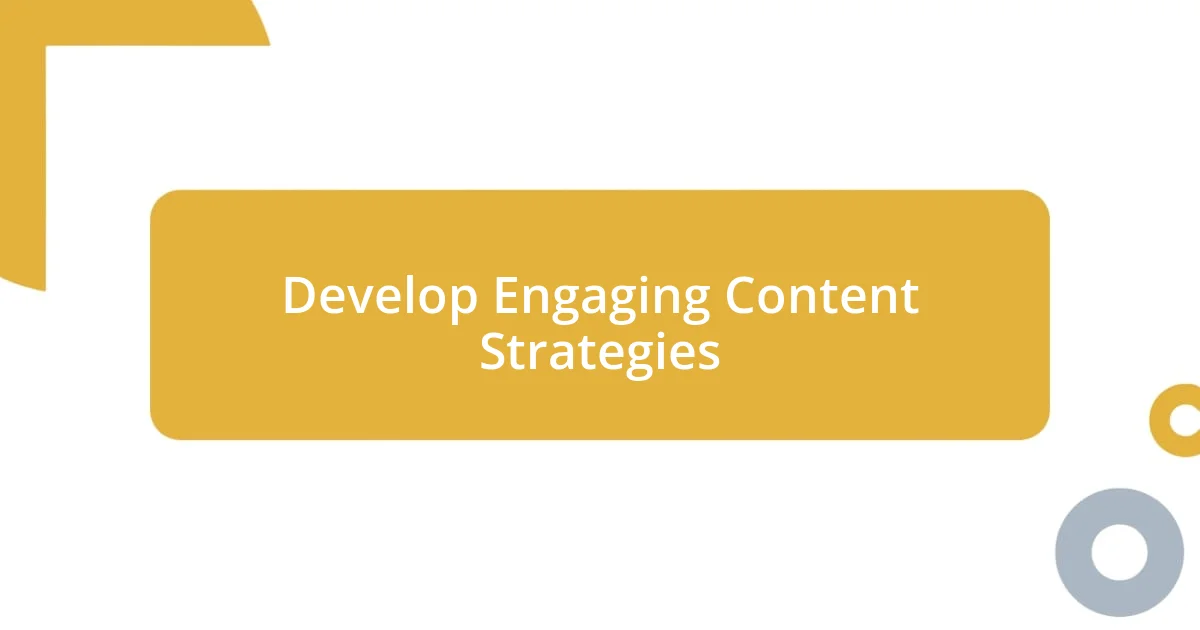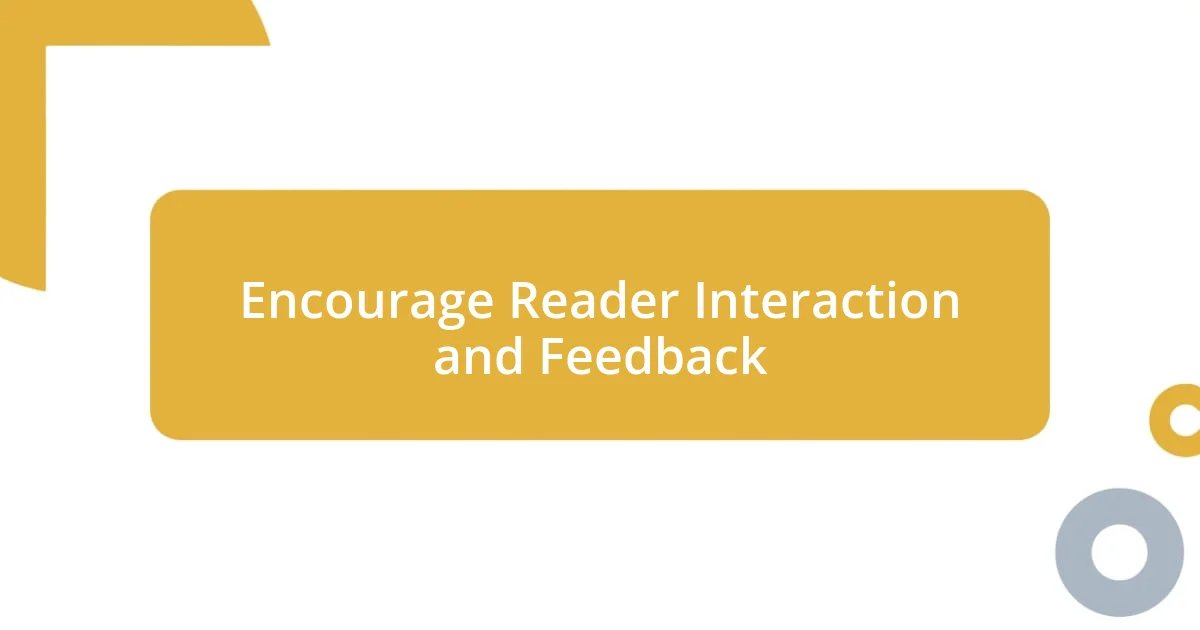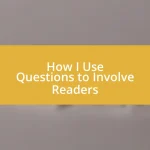Key takeaways:
- Understanding audience needs fosters genuine connections and tailored content, enhancing reader engagement.
- Incorporating varied content formats, including visuals and personal stories, keeps readers curious and increases interaction.
- Utilizing SEO techniques and creating opportunities for feedback and dialogue can significantly boost audience retention and satisfaction.

Understand Your Audience Needs
Understanding your audience’s needs is like holding a key to a treasure chest of engagement. I remember an instance when I shared a personal story about overcoming self-doubt, and the responses flooded in. Readers resonated deeply because they felt seen; they had their own battles and were looking for someone who understood their struggles.
When I tailor my content to directly address these needs, I create a connection that isn’t just superficial. It’s like having a conversation with a friend; they share something meaningful, and you reciprocate with genuine interest. Have you ever noticed how some topics generate enthusiastic discussions, while others leave readers silent? The difference often hinges on my ability to tap into the emotions and challenges that matter most to them.
Every time I analyze feedback or comments, I uncover layers of insight about what my readers truly seek. For instance, some prefer practical tips, while others crave inspiration and storytelling. By actively listening and adapting, I can cater to diverse preferences, ensuring that I meet the varied needs of my audience. It’s a continuous journey of discovery, and I thrive in that space of engagement.

Develop Engaging Content Strategies
Developing engaging content strategies revolves around experimenting with different formats and styles that resonate deeply with your audience. I once decided to switch up my typical blog posts and created an interactive quiz that related to a popular topic in my niche. The result was astonishing. Not only did it boost engagement significantly, but readers expressed how fun it felt to participate and learn simultaneously. This taught me that variety and interactivity can make a huge difference in how content is received.
Here are some engaging content strategies that I’ve found effective:
- Incorporate Visuals: Add infographics, images, or videos to break up text and maintain interest.
- Leverage User-Generated Content: Share stories or contributions from your audience to create a sense of community and involvement.
- Use Questions Throughout: Prompt readers to think critically and respond, fostering a two-way dialogue.
- Create Lists and How-To Guides: These formats are not only scannable but also provide clear, actionable steps that readers appreciate.
- Tell Personal Stories: Sharing personal anecdotes can foster connection and make your content relatable and engaging.
By mixing these strategies, I keep my readers curious and eager for the next post. It’s a dynamic process where creativity fuels connection, and I love exploring the endless possibilities!

Utilize Effective Storytelling Techniques
Utilizing effective storytelling techniques has been a game-changer in my writing approach. I recall a time when I shared a tale about a challenging journey that led to a surprising revelation. The way readers responded was incredible, as many reached out, sharing their own stories of struggle and triumph. It reminded me that storytelling transforms information into immersive experiences, allowing readers to see themselves within the narrative. Have you ever read a piece where you felt like the author was narrating your life? That’s the magic I strive to create.
One key technique is to build a vivid scene that draws readers in. I once wrote about a moment in nature that shifted my perspective. By addressing the colors, sounds, and emotions of that experience, readers didn’t just read it; they felt it. They became part of that moment. I learned that sensory details can evoke strong emotions, making the story unforgettable. It’s fascinating how a simple description can transport someone to a different place and time, isn’t it?
Another important element is to include relatable characters, whether they’re real or fictional. I often share stories that feature people I’ve encountered—friends, family, or even a stranger whose words struck a chord. These characters serve as a mirror to my readers, reflecting their struggles and victories. When readers see themselves in the stories, they’re more likely to stay engaged. After all, stories aren’t just about the experiences of others; they’re a reflection of our collective human journey.
| Storytelling Technique | Description |
|---|---|
| Vivid Scene Building | Creating immersive scenes filled with sensory details to engage emotions. |
| Relatable Characters | Incorporating people that reflect the reader’s own experiences and challenges. |

Incorporate Visual Elements Thoughtfully
Incorporating visual elements thoughtfully is something I’ve learned can really elevate a piece of content. A while back, I decided to create a visually striking infographic for a complex topic I had written about. By distilling crucial information into a vibrant visual format, I found that more readers engaged with the material. It wasn’t just about aesthetics; it was about clarity and understanding. Have you ever come across a wall of text and felt overwhelmed? Visuals can truly break that monotony.
When I use visuals, I always consider how they complement my text. For example, one time I shared a step-by-step guide on a project, accompanied by images illustrating each phase. I received feedback from several readers who expressed that the visuals clarified the process and made it more approachable. It really hit me that when visuals are purposeful, they enhance comprehension, and readers appreciate that extra layer of support.
Balancing visuals with text can be tricky, but I keep experimenting. Sometimes, I leave blank spaces intentionally to let an image breathe or to emphasize a point. There was a particular article where I used a powerful image of nature alongside a reflective piece about personal growth. The combination invited readers to pause and think. It was rewarding to see how a well-placed visual could provoke deeper reflection. What visuals have impacted your own reading experience?

Encourage Reader Interaction and Feedback
Encouraging reader interaction and feedback has been an essential part of my writing journey. I remember the first time I posed a question at the end of an article, prompting readers to share their opinions in the comments. The response was overwhelming—suddenly, my post evolved into a lively discussion, and it felt incredible to connect with my audience on a deeper level. Have you ever found yourself engrossed in a conversation sparked by something you read? Those moments enrich the experience for everyone involved.
Another method I’ve embraced is actively seeking out feedback through surveys or polls at the end of my pieces. I once sent out a simple questionnaire asking readers about topics they’d like me to cover next. Not only did I receive a treasure trove of ideas, but I also felt a stronger bond with my audience, knowing I was writing about what resonated with them. It’s fascinating how inviting input can transform a one-sided narrative into an engaging exchange. Do you think your readers would appreciate having a say in your content?
Creating opportunities for interaction, such as hosting Q&A sessions or inviting guest writers to share their insights, can also enhance engagement. I tried collaborating with a fellow blogger to answer questions submitted by readers, and it turned out to be a delightful exchange of ideas and perspectives. The community that developed from that effort continues to thrive. Wouldn’t it be wonderful to watch your readership evolve into a supportive network where everyone feels invested?

Optimize Content for Search Engines
Optimizing content for search engines is a game-changer in attracting and retaining readers. I remember when I first dived into SEO techniques; my website’s traffic skyrocketed after I learned to incorporate relevant keywords effectively. For instance, when I wrote an article on healthy living, using consistent and well-researched keywords helped my piece rank higher in search results. Have you ever noticed how certain phrases stick in your mind when searching for information online? That’s the power of SEO at work.
On another occasion, I experimented with meta descriptions and titles, focusing on captivating language that spoke directly to my readers’ interests. One particular title change transformed a modestly performing article into one of my top reads. It reminded me that search engines are not just algorithms; they reflect what people genuinely want to know. How often do you find yourself clicking on results that clearly align with your needs?
Additionally, I’ve started utilizing internal links within my articles to guide readers to related content. This not only helps in keeping them engaged but also improves my site’s ranking. I recall a time when a series of interconnected posts on personal development led to double the time readers spent on my site. It felt rewarding to see how this approach fostered a deeper exploration of topics they cared about. Isn’t it fascinating how a few strategic tweaks can create a seamless journey for your audience?














